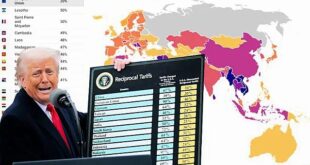The airwaves are thick with viral videos. Chinese manufacturers, once the silent backbone of Western luxury, are now pulling back the curtain. They reveal the origins of top brands, whispering tales of exorbitant markups for mere logos and packaging. Is this a genuine exposé or a calculated move in the escalating US-China tariff war, a conflict poised to reshape the global economic order?
The Looming Shadow of Tariffs:
Donald Trump, the self-proclaimed master strategist, once threatened the world with his “cards.” Yet, the transcript suggests these very cards might be “made in China.” The staggering $28 trillion American economy groans under a debt burden of 124 percent of its GDP. Can tariffs truly alleviate this pressure? The hallmarks of American innovation – Google, iPhones, ChatGPT, Windows, NASA – stand in stark contrast to the traditional industries of “pants and steel belts.” Furthermore, the dominance of the US dollar in 60 percent of international trade is now being challenged.
The transcript revisits a 50-year-old statement by Donald Trump, seemingly presented as a guiding principle. Meanwhile, China’s control over 90 percent of the rare earth materials vital for America’s modern economy paints a stark picture. The assertion is clear: “America will never be the same again. And it has a reason.”
we highlight the viral trend of Chinese influencers exposing the manufacturing secrets of Western luxury brands like Levi’s, Schnell, Hermes, Gucci, and Ralph Lauren. These brands, enjoying immense profits and prestige, cultivate an image of exclusivity cherished by the world’s elite as a symbol of superior status.
Two pillars underpin the immense value of these luxury brands: their rich history and nostalgic stories, and their perceived exclusivity. The example of French leather giant Hermes illustrates this. Founded in 1837, its logo still features a horse and cart, a nod to its origins as a maker of durable saddles for a horse-drawn era. This heritage, the transcript argues, is part of what consumers purchase – a connection to generations past.
Beyond history, exclusivity is paramount. Hermes’ unique leather dyeing, the unparalleled stitching of its artisans, and the enduring quality of its bags contribute to its unmatched status. These are items meant to be passed down as heirlooms.
However, Chinese influencers and producers are now challenging this notion of pure exclusivity. They claim that while the history of these brands is undeniable, much of their manufacturing occurs in Chinese factories, with final touches – the logo and packaging – added in France, Italy, or the USA. A product manufactured for $1400 in China, they allege, is then sold for $38,000.
The transcript concedes that these viral videos might not immediately cripple the luxury market. Yet, the erosion of brand exclusivity poses a significant threat. While these Chinese claims are not entirely accurate – the creation of a luxury brand and the mere replication of its product are different – the counterfeit market has long thrived in China. What’s new is the direct appeal from Chinese producers to bypass the middleman and acquire “A-copies” at drastically reduced prices, even factoring in US tariffs.
This strategy is deemed promising due to the existing reality: a significant portion (70%) of products on Amazon in America originate from China, alongside other platforms like Alibaba and Shopify. Markets already exist in America where Chinese-made copies of top brands are readily available. The current trade war, however, has amplified the worries of luxury brands, forcing them to defend their exclusivity by publishing maps and details of their alleged exclusive production sites, often without transparently disclosing the extent of their manufacturing in China.
But the transcript argues that this damage to the Western economy is minor compared to the larger consequence of Donald Trump’s tariff war: the global devaluation of the dollar. World trade, still predominantly in dollars (60%), is predicted to decline further. China and Russia are already conducting 90% of their trade in local currencies, with India and Brazil moving in the same direction. Even the long-standing “petrodollar” system is showing signs of potential shifts towards the Chinese currency.
The strength of the dollar since World War II rested on international consensus. By repeatedly using the dollar’s power as a weapon through tariffs, the US risks forcing powerful nations to seek alternatives in local currencies, diminishing the dollar’s demand and consequently its value. This, in turn, will exacerbate America’s already staggering debt. The transcript portrays Trump’s actions as accelerating this process, playing into the hands of his rivals.
The narrator believes Trump is trapped in a “WWII industrial nostalgia,” failing to grasp the profound shift from an industrial economy to the modern information and intelligence economy. He traces the evolution from a survival economy to an agrarian, artisan, industrial, and finally, the current Information Age, where data and intelligence are the core values. The future, it argues, lies in the “cognitive economy,” driven by AI and services, where innovation trumps sheer manufacturing output.
America, the transcript points out, leads in this modern intelligence and services economy, with 77 percent of its GDP derived from technology and related services. Yet, Trump’s “Make America Great Again” slogan seemingly harks back to a bygone era of factories and manufacturing. His focus on tariffs is likened to a three-century-old idea in a vastly changed economic landscape.
Trump’s background as a real estate developer, characterized by “manipulation and tax fraud, and false marketing,” is presented as context for his economic policies. His self-promotion, including a disputed claim of graduating with honors, is highlighted to paint a picture of a leader clinging to outdated notions of economic progress. The fact that over 77 million Americans voted for this vision is noted with concern.
Trump’s enthusiastic pronouncements about tariffs during his campaign are recalled, contrasting with the warnings from economists about the burden ultimately falling on the American people. The transcript provides a clear example: a $100 Chinese leather bag, subject to a 100% tariff, doubles in price for the American importer, who then passes this cost onto the consumer. While Trump’s “dumb logic” suggests this will revive local industries, the reality is far more complex.
America’s economy has fundamentally shifted. In 1950, 30 percent of its GDP relied on manufacturing; today, it’s a mere nine percent, with 80-85 percent residing in the services sector. Americans prefer jobs in education, IT, automation, AI, and e-commerce, offering remote work, innovation, rapid growth, and easy job mobility – starkly different from the factory floors of the past.
The “Steel Belt,” once the heart of American industry, has transformed into the “Rust Belt” as factories disappeared and jobs were outsourced. While this caused temporary hardship, it was a sign of America’s early modernization and diversification towards a “thought economy” driven by capital and trust in ideas – the “American Dream.” The challenge, according to the transcript, is to accelerate this modern path, not to reverse it with nostalgic appeals to past industrial glory.
Trump’s disruptive approach to international trade is analyzed through the lens of his past business dealings. His history of capitalizing on chaos, exemplified by his real estate ventures in 1970s New York, where he leveraged political connections for tax breaks and subsidies, is presented as a pattern. His boastful self-description as “progressive” in a scenario where he hadn’t achieved massive success suggests a calculated strategy of waiting for or even creating favorable circumstances. This mindset, matured and applied globally, frames his “Art of the Deal” not as skillful negotiation but as “the art of fraud,” a characterization supported by the ghostwriter of his book who expressed shame for “putting lipstick on a pig.”
Trump’s attempt to bully the world with tariffs, treating nations like New York mayors or rival real estate groups ripe for deals, misjudged both allies and adversaries. The consequences, the transcript argues, will be borne by the American people, as the American economic and social structures are incompatible with a return to old-style manufacturing.
The low unemployment rate (4.2%) reflects a workforce not seeking factory jobs. Reviving manufacturing would necessitate massive immigration, contradicting Trump’s policies. Furthermore, American labor laws and human rights standards would make domestically produced goods at comparable prices to imports unaffordable for the middle class, potentially fueling smuggling and further devaluing the dollar.
In contrast, China has been preparing for this economic war since the “Covid War,” steadily reducing its dependence on the American market. Exports to the US fell from 20 percent in 2018 to 14.7 percent in 2024. China also holds a strategic advantage in its control over 90 percent of the world’s rare earth mineral supply, crucial for America’s cutting-edge technology, defense industry, and semiconductor manufacturing. America possesses only one mine and is entirely reliant on Chinese minerals for critical components in everything from F-35 jets and missiles to smartphones and AI infrastructure. The transcript suggests Trump’s understanding of these complexities is limited, recalling a 1984 article where he admitted to selling “fantasy” over substance.
The “Great Tariff and Trade War” has fully erupted. The Chinese response, unlike the initial influencer videos, has been direct and impactful. China has reportedly halted the supply of six to seven heavy rare earth minerals vital for semiconductors and the aviation industry – production and processing of which are entirely within China.
Unless the American President retreats, this economic conflict risks escalating into a hot one. While Trump might attempt to reverse course, the transcript asserts that one thing is irreversible: the erosion of the world’s trust in the dollar and American promises. Just as the Russia-Ukraine war has reshaped global power dynamics, Trump’s tariff policies are predicted to forge a new economic world order, one with reduced reliance on America, the creation of new markets and trade routes, and the end of the post-World War II business order. Rebuilding the American-led order, it concludes, hinges on significant positive change within America, particularly addressing its massive debt burden. The transcript directs viewers to further resources exploring America’s debt and the superpower competition between the US, China, and Russia.
 ODosta Inc. Create Your Own Tech World
ODosta Inc. Create Your Own Tech World








